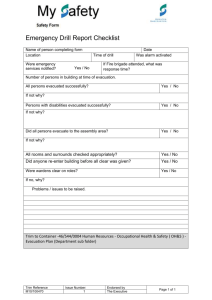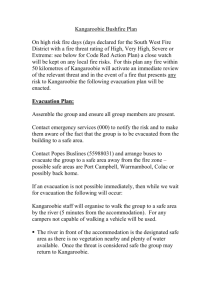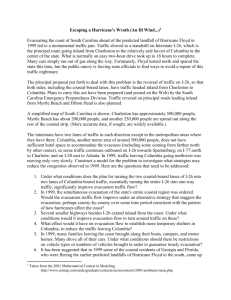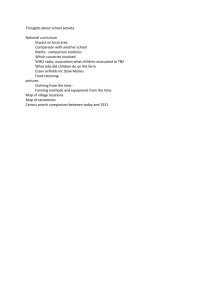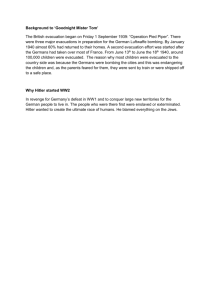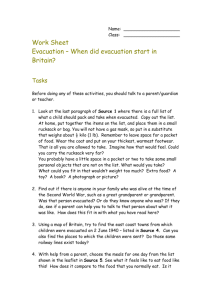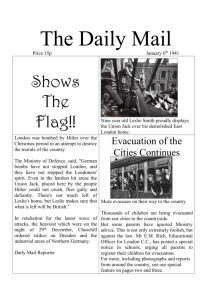What If Another Floyd? - Escaping a Hurricane’s Wrath
advertisement
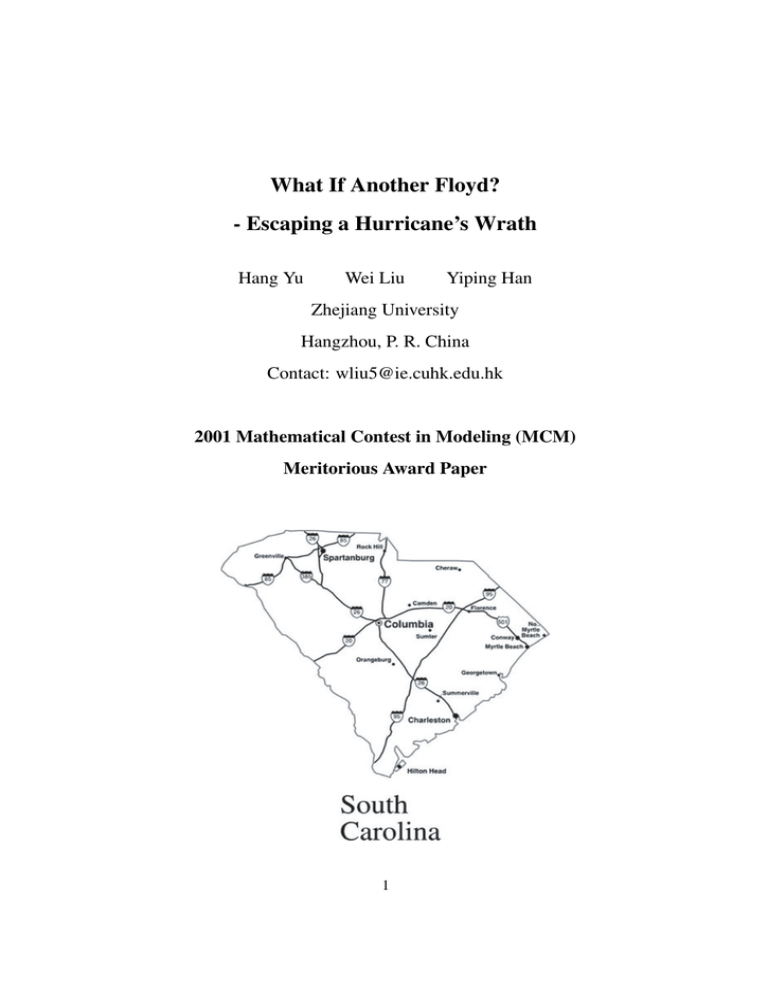
What If Another Floyd?
- Escaping a Hurricane’s Wrath
Hang Yu
Wei Liu
Yiping Han
Zhejiang University
Hangzhou, P. R. China
Contact: wliu5@ie.cuhk.edu.hk
2001 Mathematical Contest in Modeling (MCM)
Meritorious Award Paper
1
Abstract
The State of South Carolina is very vulnerable to the attack of hurricanes since it is adjacent with
the Atlantic Ocean. In 1999 hurricane Floyd led most people living in the coastal region into a
great panic. Take the city of Charleston as an example, 500,000 people rushed to Columbia, a
safety heaven more than 200 kilometers away, through Interstate I-26. Since I-26 is the principal
route going inland from Charleston to Columbia, there happened a standstill on the I-26. What is
normally an easy two-hour drive took up to 18 hours to complete. Many cars simply ran out of gas
along the way. Fortunately, Floyd turned north and spared the state this time, but the public outcry
is forcing state officials to find ways to avoid a repeat of this traffic nightmare.
The principal proposal put forth to deal with this problem is the reversal of traffic on I-26, so
that both sides, including the coastal-bound lanes, have traffic headed inland from Charleston to
Columbia. We have set up a mathematical model to analyze this problem. Our conclusion is that
the performance of the evacuation plan would be greatly improved. According to our estimation,
it will take more than 40 hours for 500,000 people if the traffic on the coast bound lanes are not
reversed. But after the lanes are reversed, only about 24 hours will be enough for 500,000 people,
which is a great improvement. So we suggest that under very urgent situations all lanes of traffic
should be forced to extend inland. With more exact calculations we suggest that if more highways
of small scales extending inland are available, we not hesitate to open them and utilize all its inland
bound lanes.
If people from more than one place wait for being evacuated, then another method should be
presented. We may consider an alternative strategy, which staggers the evacuation, e.g. city by
city, to further improve the evacuation plan’s performance. Under certain conditions we notice hat
if all the people evacuate simultaneously it will lead to a disastrous result but that if they evacuate
in turn they can avoid this. This phenomenon urged us to study what lies behind it. After extensive
analysis we found out that it has something to do with the different time at which the hurricane
will arrive in different places. A model is then set up and a recursive algorithm is proposed. This
algorithm can help the decision maker to decide under what conditions a staggered strategy is
called upon and what is the turn for evacuation of those cities.
2
If we go deep into this problem we should take the accommodating ability of those destination
cities into consideration. For instance, the city of Columbia only has fewer hotel rooms than what
is enough for the 500,000 or more people coming from the coastal area. People will simply choose
to go on in their directions if they haven’t got rooms. So the traffic outside Columbia will be greatly
burdened. We suggest that the government of Columbia build more shelters, such as the temporary
camps, to relieve the conflict. We can apply our model to work out the exact number of shelters
that ought to be built given the total number of people to be evacuated.
We also pay attention to some details that are usually neglected by some people. First the type
and the number of the vehicles on the road should be placed under strict restrictions to guarantee
timely evacuation. Second we will need to make necessary changes to our plan if the evacuees
form neighboring states come up to our state. The detailed changes depend on how earlier the
neighboring states received the hurricane alarm than us.
1 Introduction
Evacuating the coast of South Carolina ahead of the predicted landfall of Hurricane Floyd in 1999
led to a monumental traffic jam. Traffic slowed to a standstill on Interstate I-26, which is the
principal route going inland from Charleston to the relatively safe haven of Columbia in the center
of the state. What is normally an easy two-hour drive took up to 18 hours to complete. Many
cars simply ran out of gas along the way. Fortunately, Floyd turned north and spared the state this
time, but the public outcry is pushing state officials to find ways to avoid a repeat of this traffic
nightmare.
The principal proposal put forth to deal with this problem is the reversal of traffic on I-26,
so that both sides, including the coastal-bound lanes, have traffic headed inland from Charleston
to Columbia. Plans to carry this out have been prepared (and posted on the Web) by the South
Carolina Emergency Preparedness Division. Traffic reversal on principal roads leading inland
from Myrtle Beach and Hilton Head is also planned.
A simplified map of South Carolina is shown in the picture of the cover page. Charleston
has approximately 500,000 people, Myrtle Beach has about 200,000 people, and another 250,000
3
people are spread out along the rest of the coastal strip. (More accurate data, if sought, are widely
available.)
The interstates have two lanes of traffic in each direction except in the metropolitan areas where
they have three. Columbia, another metro area of around 500,000 people, does not have sufficient
hotel space to accommodate the evacuees (including some coming from farther north by other
routes), so some traffic continues outbound on I-26 towards Spartanburg; on I-77 north to Charlotte; and on I-20 east to Atlanta. In 1999, traffic leaving Columbia going northwest was moving
very slowly.
To solve this problem people aim at developing an effective model that would lead to practical
strategies. Several important questions must be addressed. First, it is necessary for people to decide
under what conditions should the lane be reversed. Then people have to find some measurements
to evaluate the performance of different strategies. A staggered evacuation strategy should also be
discussed in order to observe what extent it could improve the performance of the simple evacuation strategy. What’s more, the model must be robust enough to accommodate many uncertain
situations and sudden changes.
2 Assumptions and Symbols
Assumptions:
• Among all available highways, only those inland or coast bound are considered. Those ways
parallel to the coast are not considered as evacuation routes.
• Since reversing traffic on a highway may bring additional cost (for instance, we need assign
more police to administer the traffic), we will reverse the traffic on an additional lane only if
the original lanes cannot carry their car flow.
• Normally the movement speed of a hurricane is quite slow. Thus, cars running on a highway
at a speed bigger than the hurricane. Only those cars don’t set off the coast will be affected
by the landfall of the hurricane.
4
• Before the emergent evacuation is started and after the evacuation is over, the highways are
considered to have no vehicle on them. Although they might actually carry a few vehicles
on them, it is reasonable to omit them because their number is too small compared with the
large car flow during the evacuation.
• During the emergent evacuation, the car flow on a highway can be viewed as a stable flow,
in which all the vehicles are moving at a same speed and the distance between two adjacent
vehicles are the same.
• Although various vehicles have various sizes, we assume that all vehicles have a same size,
which can be determined by the average size of common vehicles.
Definitions:
• P (t): the number of people that have been evacuated by the time t.
• N0 : the number of people to be evacuated.
• N : the number of cars to be evacuated.
• Q: the flow of a highway, which means the number of vehicles passing through any section
of this highway per hour.
• K: the vehicles density of a lane, which means the number of vehicles in a highway per
kilometer in a stable condition. Its unit is km−1 .
• U : the speed of the cars on a highway.
• Nl : the number of lanes in one direction on a multi lane highway.
• T : the security time within which all the people must be evacuated. This security time
is usually determined by the time interval between the prediction of the hurricane and its
landfall.
• T0 : the actual time it takes for all the N0 people to evacuate from the coast.
• H: the average number of people per car during the emergent evacuation, N = N0 /H.
5
• L: the distance between two places.
3 Preliminary Analysis
Our task, known as the emergency evacuating problem, is to devise a strategy to evacuate all the
coastal people (the total number is N0 ) in a given period of time T . Let P (t) be the number of
people that can be evacuated within the given time T . Therefore if P (T ) ≥ N0 , the evacuation
strategy is successful while it is unsuccessful if P (T ) ≤ N0 .
3.1 A Single Lane Model
First, we set up the single lane highway model. We usually use three important parameters to
describe a single lane: the car flow Q, the car density K and the speed of the cars U . Their
definitions have been given in the previous part. Considering their definitions, we know that Q =
KU . According to Greenshields [4], we have
U = Uf (1 −
K
),
Kj
(1)
where Uf and Kj are parameters need to be determined. This linear formula Eq. (1) can describe
the relationship between car density and speed quite well. We plot the function U (K) in Fig. 1.
Figure 1: Function U (K).
From practical data Greenberg proposed a more accurate model, in which he pointed out that
when the car density exceeds a certain threshold, usually 75 km−1 , the relationship is logarithmic,
6
which is given by:
U = Um ln(
Kj
),
K
(2)
where Um and Kj are parameters need to be determined.
When the car density is below 75 km−1 , Underwood pointed out that the relationship turns
exponential, which is given by:
U = Uf exp(−
K
),
Km
(3)
where Uf and Km are parameters need to be determined. We also plot the functions Eq. (2)(3) in
Fig. 2.
Figure 2: Functions U (K).
We have found out the following data [1], which describe the relationship between a car’s speed
and the car head time gap defined as the time difference between two adjacent cars measured from
head to head (see Tab. 1).
Table 1: Car’s speed vs. car head time gap.
Speed (kph)
50
46
40
35
30
Time Gap (s) 2.13 2.16 2.20 2.26 2.33
7
Figure 3: Distance between two adjacent cars.
Table 2: Car density.
Speed (kph)
50
46
40
35
30
Time Gap (s) 2.13 2.16 2.20 2.26 2.33
Dist (m)
30.0 27.6 24.5 22.0 19.5
Density (km−1 ) 33
36
41
45
51
We can use these data to calculate the distance between two adjacent cars (shown in Fig. 3),
which is given by:
Dist = T imeGap ∗ Speed.
(4)
Since we also have
Density =
1
,
Dist
(5)
we get out the car density under these five situations (see Tab. 2). We can see that all the five
densities are below 75 km−1 , thus we are able to use the Underwood exponential model. We
then use these five couples of data to determine the parameters Uf and Km of the model: Uf =
128.98 kph and Km = 35.14 km−1 . The speed and the flow can be determined by:
U = 128.98 exp(−
K
).
35.14
U = 128.98K exp(−
K
).
35.14
(6)
(7)
Let dQ/dK = 0, then we can work out the maximum of Q, which is 1672 cars per hour (cph)
while K = Km = 35.14 km−1 and U = Um = 47.59 kph. It means at most 1672 cars can pass
8
through a single lane per hour. That is the largest road capacity of a lane. Thus we may calculate
the total time it takes for all the coastal people to evacuate:
T0 =
N
N0
=
.
Qmax
Qmax H
(8)
We assume that a car takes 4 people (H = 4) on average and the Charleston has a population of
552,803 (N0 ). Then we get T0 = 74.76 hours.
3.2 A Multi-Lane Model
The above result is achieved only for a single lane highway. We learn from the problem that a
common highway has two lanes in one direction. If we have Nl lanes in one direction we call this
highway a 2Nl -lane highway. For instance an 8-lane highway has 4 lanes for one direction each.
By extending our single lane model, we may easily derive a multi lane highway model. We then
can calculate the total time now:
T0 =
N
N0
=
.
Qmax
Qmax HNl
(9)
If we adopt the traffic reverse strategy and there are Nx inland bound lanes in all then T0 is given
by:
T0 =
N
N0
=
.
Qmax
Qmax HNx
(10)
4 Development
4.1 Single-Source Single-Destination Evacuation Model
The simplest form of the evacuation problem is to evacuate people from one place to another place
connected by a single highway. Applying our multi lane model, we may easily work out this
problem. Take what happened in South Carolina during the 1999 Floyd Hurricane as an example.
About 500,000 people in Charleston have to be evacuated to Columbia, which is about 225 km
away, through the interstate highway I-26. Suppose a car can take 4 people (H = 4) and the city
of Charleston has 552,803 (N0 = 552, 803) then we have got T0 = 37.38 hours by Eq. (9) if no
lanes are reversed.
9
Table 3: Reversed lanes vs. hours.
Reversed Lanes
T0 (hour)
None Reversed
37.38
One Reversed
24.92
Two Reversed
18.69
Considering that I-26 has two coast-bounded lanes that can be reversed, T0 can be further reduced by adopting the traffic reverse strategy (see Tab. 3). From Tab. 3 we learn that at least 18.69
hours are needed for all the people of Charleston to be completely evacuated.
We can modify this model for a more accurate result. Considering that the single lane model
is based on an assumption that there exists a stable car flow on the road, we have to calculate the
set-up time of the stable condition. We may suppose that at the beginning, the highway is empty
thus the set up time Tsetup will be:
Tsetup =
L
Umax
= 4.73,
(11)
which is also the time an individual car will take in driving from Charleston to Columbia during
the emergent evacuation. According to the 1999’s report “What is normally an easy two-hour drive
took up to 18 hours to complete”, if we reverse traffic on two of the coast-bounded lanes of I-26,
the situation will be greatly improved. More detailed plan of whether one lane or two lanes ought
to be reversed depends on how long the security time T is.
We also notice at the end of the evacuation process the car flow on the highway cannot be viewed
as a stable flow either. The highway with a stable flow will gradually turn empty at last. We do not
have to include this period of empty time in the total time since we have already assumed in the
previous part that every car already running on the highway will not be attacked by the hurricane
because the hurricane moves more slowly than the car.
Thus the rectified total time Tr for all the people to be evacuated when no lanes are reversed will
be:
Tr = T0 + Tsetup = 42.11.
10
(12)
4.2 Solution for Problem One
Therefore when the security time is longer than 42.11 hours it is not necessary to reverse traffic on
the other 2 lanes. But when it is shorter than 42.11 hours, the traffic on the other two lanes should
be reversed. Be aware that this result can only be achieved when the police strictly control the flow
of a road at 1672 h−1 per lane.
5 Staggered Evacuation Strategy
In the previous model, only evacuation of the people in Charleston is considered. But we all
know that in the reality almost all the cities along the coast are under the threat of hurricanes so
we need to evacuate all of them. What’s more, we should also take the hurricane’s pattern into
consideration. It means that the hurricane would arrive at different places at different time. Under
such circumstances a staggered strategy may be more effective. We develop a recursive algorithm
to determine under what conditions staggered strategy should be adopted and how the staggered
strategy should be carried out.
As Fig. 4, suppose we are to evacuate people from n cities C1 , C2 , · · · , Cn to a safety place D.
Only city C1 has a principle highway leading to city D, whose road capacity is Q (h−1 ). The other
n − 1 cities each has only one road to city C1 . The population of each city is denoted by Pj . The
security time of each city, denoted by Ti , varies since the hurricane will attack them at different
times. Let t(j) denote the time that city Cj needs to evacuate its entire people if all its people use
the principle highway exclusively. It is given by T (j) = Pj /Q. Our task is to determine whether
the staggered strategy should be adopted and, if it should be, in what sequence will the cities be
evacuated.
Whatever strategy may be adopted, the total time for evacuating all the people remains unchanged:
Pn
Ttotal =
j=1
Q
Pj
.
Our recursive algorithm goes through the following procedures:
Input. The cities to be sequenced
Output. Sequenced Cities
11
(13)
Figure 4: Staggered strategy.
Step 1. Check whether Tj ≥ Ttotal is satisfied for all the cities {Cj }. If satisfied, then it is certain
that a staggered strategy is unnecessary. All strategies will be successful, go to Step 7.
Step 2. Check whether t(j) ≤ Tj is satisfied for all the cities {Cj }. If there exists a Tj that
satisfies t(j) > Tj , then the people of city Cj will never be completely evacuated within its security
time Tj . So any strategy will be unsuccessful, go to Step 7.
Step 3. Check how many cities satisfy t(j) = Tj . If there are two or more, one of them cannot
be safely evacuated. So any strategy will be unsuccessful, go to Step 7. If there exists only one
city satisfying the equation, then denote this city as city Cf and continue.
Step 4. Count the number of cities as A. Set priority value to be 1, 2, · · · , A. The city with
priority 1 will be evacuated first and the one with priority A will be evacuated at last. The priorities
are assigned to the cities according to the following rules:
Rule 1. Assign priority 1 to city Cf if it exists.
Rule 2. All those cities satisfying Tj ≥ Ttotal will be assigned with priorities A, A−1, A−2, · · ·.
The actual sequences of these cities themselves can be arbitrary.
If city Cf exists or at least one city satisfies Tj ≥ Ttotal , then go to Step 5; otherwise any strategy
will be unsuccessful, go to Step 7.
Step 5. If city Cf exists, let Tj = Tj − Tf for all those unassigned cities Cj .
Step 6. Apply this algorithm again to those unassigned cities to get their sequences. Integrating
12
the output sequences of all the cities, we finally get the sequenced cities.
Step 7. End.
5.1 Solution for Problem Two
We may take the 1999 Hurricane Floyd as an example. The city of Charleston has a population of
about 500,000, Myrtle Beach has a population of about 200,000. About 250,000 people are spread
along the coast. We assume that those 250,000 live in two separate cities A and B with 125,000 in
each one. Assume that the hurricane will arrive in city A in 10 hours. Charleston 25 hours, City B
30 hours, Myrtle Beach 36 hours. Only an interstate highway I-26 connects Columbia, a safe place
and Charleston. Its road capacity is 1672*4=6688 (1/h) so the t(i) for each city is that City A 4.67
hours, City B 4.67 hours, Charleston 18.7 hours and Myrtle Beach 7.48 hours. If we do not adopt
the staggered strategy all the 950,000 will be evacuated in 35.5 hours, which means only Myrtle
Beach can be evacuated safely. But if we adopt the staggered strategy with the sequence City A,
Charleston, City B and Myrtle Beach, the four cities will be evacuated in 4.67 h, 23.4 h, 28.0 h
and 35.5 h. Thus all of them can be evacuated safely adopting the staggered strategy (see Tab. 4).
6 Multi-Source Multi-Destination Evacuation Problem
6.1 Network Flow Model
Considering that we actually have more than one highway to use, we set up a net flow model
catering to the reality. Under such circumstances people from several coastal places are to be
Table 4: Evacuation hours.
City A
Charleston
City B
Myrtle Beach
Population
125,000
500,000
125,000
200,000
Security Time
10 h
25 h
30 h
36 h
T
4.67 h
18.7 h
4.67 h
7.48 h
13
evacuated in order to avoid the hurricane. Their destinations are inland places, which are able
to hold them. This evacuation problem can be called multi-source-multi-destination evacuation
problem.
We can use a network as Fig. 5 to denote the actual routes. Here a highway can be viewed
as a combination of separate road pieces, which are divided by interchanges. A road piece is
denoted by a single edge in the network. Each edge has a direction leading inland. Vertices in
the network denote interchanges of highways. Besides, the source and destination cites are also
denoted by vertices. Each edge has three parameters: length of this road piece, the maximum car
flow which the highway can carry and the actual car flow the highway carries. We use Pi to denote
the vertices and Ei to denote the edges. We are to determine the maximum number of people that
can be evacuated through this network within time t. To do this we may work out the maximum
flow in this network, which means the maximum of the flow that passes to the destination while
it satisfies the restriction of each edge’s capacity. We derive a new algorithm from the traditional
Ford-Fulkerson algorithm to work out the maximum flow of the network. We have made a few
modifications. For instance, we treat the forward edge and backward edge the same. Another
modification we introduced is dynamic schema, which always promises us to get the maximal flow
at a short time.
Figure 5: The network flow model.
We now define a new term “lane equivalent”, which we use “l.e.” in short. This term is a unit
that describes the road flow on a multi-lane highway. 1 l.e. equals the maximum flow on a single
lane, which is 1672 cars/h. Thus 1.6 l.e. means that the car flow is 1672*1.6=2675.2 cars/h.
Notice that 1.6 l.e. does not mean that we will use 1.6 lanes on a multi lane highway (the number
14
of used lanes must be an integer) but that the flow is about 2675 cars/h. Virtually we will use 2
lanes to accommodate 1.6 l.e., each lane having 1338 cars/h (0.8 l.e.).
If we adopt the traffic reverse strategy we may have up to 4 lanes on one way extending inland.
Then the road capacity will be 4 l.e.. The actual number of lanes that will be reversed is determined
by the result of the improved maximum flow algorithm. We use Li to denote the actual flow that
will be distributed on edge Ei . Then the traffic reverse strategy will be:
If Li ≤ 2 l.e. then we don’t have to adopt the traffic reverse strategy. The original lanes can be
used.
If 2 l.e. < Li ≤ 3 l.e. then we should adopt the traffic reverse strategy. One lane will be
reversed.
If 3 l.e. < Li ≤ 4 l.e. then we also should adopt the traffic reverse strategy. Two lanes will be
reversed.
Let us take the actual map of SC as an example. The result is shown in Fig. 6.
Figure 6: The maximal flow method.
15
6.2 Solution for Problem Three
In the actual situation, several smaller highways besides I-26 extend in land from the coast. If we
turn some traffic around onto these roads the performance of the evacuation may be improved. We
can use our network flow model to describe the situation. First we assume that these highways
are not available. We calculate the maximal car flow the original network can carry. And then we
add these smaller highways into our network and calculate the maximal network flow again. If the
result is larger than the previous one, it is worthwhile to open these highways. If not then it is a
waste to open them. That is how we decide whether the extra highways should be turned to use or
not.
6.3 Solution for Problem Four
In the previous discussion we neglect the actual accommodating ability of the destination city. We
had assumed that the destination city can hold as many people as there are, but it is not true in the
reality. For instance, Columbia does not have sufficient hotel space to accommodate the evacuees
(including some coming from farther north by other routes), so some traffic continues outbound on
I-26 towards Spartanburg; on I-77 north to Charlotte; and on I-20 east to Atlanta. In 1999, traffic
leaving Columbia going northwest was moving only very slowly. One way to reconcile the conflict
is to build more shelters in Columbia. Our network flow model can also be used to determine to
what extent it can reduce the traffic leaving Columbia.
First, we introduce a new term “virtual route”. In our previous model the vertices that stand for
interchanges can accommodate nothing so the inward flow must equal the outward flow at such
vertex. For Columbia since it is the destination vertex, it only has inward flow but no outward flow.
In this question Columbia will be not be considered as a destination vertex but also an interchange.
The network flow model allows no accommodation for a vertex so we must use a “virtual route”
to “transfer” all the people in the shelters. This virtual route extends from Columbia to another
“virtual city”. Its maximal road capacity equals the number of people accumulating in the shelters
per hour (see Fig. 7).
With the concept of “virtual route” we may solve Requirement Four. We first add this virtual
16
Figure 7: Virtual route.
route and the virtual city into our network and then calculate the maximal flow the network can
carry again. We can also know the car flow on the virtual route and the total time it takes for all
the people to evacuate. Multiply the two terms and then we get the accommodating ability of the
shelters. The actual shelters built can not be smaller than this number.
6.4 Solution for Problem Five
In 1999, many families leaving the coast brought along their boats, campers, and motor homes.
Many drove all of their cars. So under certain conditions there should be restrictions on vehicle
types or numbers of vehicles brought in order to guarantee timely evacuation.
Using our network flow model and the Ford-Fulkerson algorithm we can work out the maximum
flow of the network Qmax , which equals the number of cars arriving at the destination per hour.
Suppose the security time is T0 , the maximum cars that can be evacuated within T0 are QT0 . If
QT0 < N0 /H then some people will not be evacuated timely. One way to solve this problem
is to increase H, which means that a car should carry more people. For instance if the security
time is 24 hours and the maximum flow of the network is 5000 (1/h) then the number of cars can
be evacuated is 24*5000=120,000. Therefore if 500,000 people ought to be evacuated it must be
ordered that a car must carry at least IN T [500, 000/120, 000] + 1 = 5 people.
Another important factor that we should take into account is the type of vehicles. In our single
17
lane model when we work out the maximum of the car flow we also learn that the vehicles must
move at 47.59 kph under such condition. But some vehicles cannot move so fast. For instance,
motor homes or cars carrying very large items like boats or campers may not move at such a speed.
Because of this, the government should enact a law that forbids those vehicles moving more slowly
than 47.59 kph to evacuate. Considering that it is very difficult for a vehicle to maintain its peak
speed at any time, a relaxation is allowed. So the speed lower bound can be 50 km/h.
6.5 Solution for Problem Six
Our model can be applied to solve this problem with a few changes. Considering that the Georgian
car flow came up I-95 fleeing earlier predicted landfalls of Hurricane Floyd to the south, we may
suppose that when the Georgian cars embarked on the highway, I-95, I-26 and other highways are
all nearly empty, we may apply the improved maximal flow algorithm now to see how much road
capacity is occupied by Georgian cars. And then subtract the occupied flow from those highways’
maximal road capacity and apply the maximal flow algorithm again. The result can be viewed as
the actual car flow when Georgian cars come. Compare this actual flow with the normal car flow
when no Georgian cars come we can see how big the impact is.
7 Evaluate Different Evacuation Plans
The most important standard to evaluate an evacuation plan is whether it can evacuate all the people
within the given security time. Of all our models we always stick to this standard, which means
that we will sacrifice anything else to evacuate all the people before the landfall of the hurricane.
The other two reasonable standards are how many people a plan can evacuate per hour (the more
the better) and how many lanes a plan will reverse (the fewer the better). It is hard to say which of
the other standards is more important. They are opposite to each other. If we want to fit better to
one standard the other must be sacrificed.
18
8 Strengths and Weaknesses
Although our tasks are to solve evacuation problems for the state of South Carolina we can see that
our network flow model is very vigorous. It can deal with evacuation problems anywhere without
any specific restriction. For instance if the highways in the network each has a different number of
lanes we can adjust our model by changing the weight of each edge. We have developed a program
that can devise the evacuation plan automatically after the principle routes, population of each city
and the hurricane pattern are inputted into the computer. Thus we dare say that our model can be
put into practical use.
We want to improve our model by a switching method. Actually the evacuation plan we get
might not be the best. The evacuation time might not be the least in the multi-source multidestination model. To get better results a more accurate piecewise model can be set up. In this
model the maximal flow algorithm is reapplied every time a destination has been fully evacuated
and the flow may be switched after this procedure. So making a few adjustments during the switching process is necessary. This modified algorithm can greatly improve the performance.
Our model performs quite well under various accidental situations. For instance it may deal with
the sudden accident on a road. If a car has been smashed, all the cars behind the smashed car will
be blocked. When it happens we only have to make a few changes to our network flow model, that
is, to split the edge into two edges at the place where the smashed car is.
The weakness of our model is that it is not optimal for the specific SC map so it might not yield
the best result for this certain problem. But it is the price of its generality.
9 Summary
In order to solve the evacuation problem, we first set up a single lane model to describe the traffic on
a highway. A preliminary model to calculate the car flow on a single lane road is then developed.
Further we extend this preliminary model to common multi-lane highways. This model can be
used to work out the single-source single-destination evacuation problem.
To cater to the actual needs we build a more general multi-source multi-destination evacuation
model. The core of this model is to propose a modified network flow algorithm appealing to the
19
traditional Ford-Fulkerson algorithm. We apply the proposed algorithm to the real Hurricane Floyd
of 1999, achieving sufficiently satisfactory results. To make the model more realistic and to widen
its range of applications, many aspects are considered. For instance a “virtual route” technique is
introduced to figure out the shelter-building problem.
What’s more, a staggered evacuation method is discussed. In order to decide whether a staggered
method should be adopted and how the staggered method is carried out, we develop a recursive
algorithm to assign priorities to those cities. According to their priority the cities are evacuated
one by one.
References
[1] J. H. Banks, Introduction to Transportation Engineering, 2nd edition, McGraw-Hill, 2002.
[2] L. R. Ford and D. R. Fulkerson, Flows in Networks, Princeton University Press, 1962.
[3] L. R. Ford and D. R. Fulkerson, “A Simple Algorithm for Finding Maximal Network Flows and an
Application to the Hitchcock Problem”, Canadian Journal of Mathematics, 9:210-218, 1957.
[4] B. D. Greenshields, “A Study of Traffic Capacity”, Proceedings of the Highway Research Board,
14:448-477, 1935.
[5] M. J. Smith, “Traffic Control and Route Choice: A Simple Example”, Transportation Research,
13B:289-295, 1979.
[6] P. A. Steenbrink, Optimization of Transportation Networks, John Wiley & Sons, 1974.
[7] J. M. Thomson, Great Cities and Their Traffic, London, Gollancz, 1977.
20
